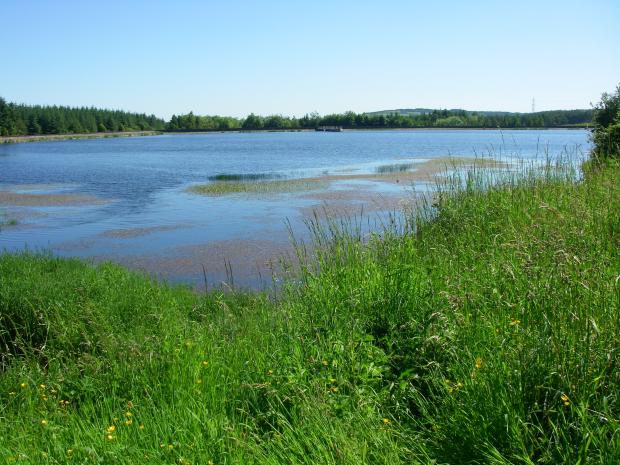
North Woodburn has been declared as an ASSI because of its variety of bryophytes. Situated in the hills above Carrickfergus, the fluctuating water levels of North Woodburn reservoir provides habitat for a group of specialist mosses, some of which are rare. These mosses grow on exposed mud in the zone around the edge of the reservoir. They tend to be short lived, appearing in early winter or spring following a lowering of the water-levels.
A bryophyte survey was carried out on North Woodburn Reservoir in 1999, which resulted in the discovery of three rare bryophytes associated with exposed mud. Of these, the most notable record is for Prickly Earth-moss , a tiny moss with sharply-toothed leaves which was found on exposed damp silty mud, close to a small inlet stream.
The second rare bryophyte is Beaked Beardless-moss, which has few records in Northern Ireland and is mainly associated with reservoirs in County Antrim. The third rare bryophyte is Dwarf Bladder-moss which was found on open, humic silty-clay and is associated with vascular plants which are characteristic of the zone most likely to flood, such as Toad rush, marsh yellow-cress, Redshank,water-pepper and marsh cudweed. It is only found on one other reservoir in County Antrim and has no other known populations in Ireland.
Further diversity is provided through a narrow stretch of species rich grassland which edges the reservoir. It is typically grass-dominated with a wide range of associated herbs. The grasses Yorkshire-fog, red fescue, crested dog’s-tail and sweet Vernal-grass are common. Herbs typical of traditionally managed grasslands are frequent throughout the sward and include common knapweed, eyebright, yellow-rattle and a lady’s-mantle and heather is present where the soils are more acidic.
North Woodburn Reservoir provides an important habitat for plants and animals, including birds, mammals and invertebrates. For example, Common Blue Damselfly Enallagma cyathigerum and Blue-tailed Damselfly Ischnura elegans and Otter Lutra lutra have been recorded on the site. It is hoped that continued sensitive management of the area will ensure that the rich assemblage of species is maintained.
Related articles
- ASSI Guidance for Public Bodies/Competent Authorities
- Coastal Areas of Special Scientific Interest
- Conservation Management Plans (CMPs)
- European Marine Sites - Marine Special Areas of Conservation and Special Protection Areas
- Introduction to Conservation Management Plans (CMPs) for Northern Ireland’s Special Areas of Conservation
- Marine Conservation Zones
- Marine Protected Areas
- Marine Ramsar sites
- Portrush Coastal Zone
- Special Areas of Conservation
- Special Areas of Conservation for Harbour porpoise
- Special Protection Areas
